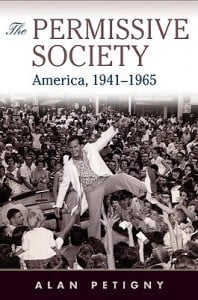If you can remember the 1960’s, the old line goes, you weren’t really there. “There,” of course, means the counterculture represented by Woodstock, hallucinogenic drugs, antiwar protests, and Haight-Ashbury. “The 60’s” didn’t actually begin in 1960, but by the “Summer of Love” in 1967 they had clearly arrived. The Beatles eventually became counterculture icons while using LSD and recording psychedelic anthems, but when they first appeared on The Ed Sullivan Show in 1964 they were wearing jackets and ties and singing about holding hands.
The clichéd oversimplification of the two decades that began in 1950 portrays the first as a time of conservative conformity, and the second as a tumultuous period of social revolution and individualism. This simplistic notion falls apart for the obvious reason that no special change occurs at midnight on January 1 in a year ending in zero. But one notes also that the supposedly bland, conformist 1950’s witnessed the publication of Lolita and Howl, while the 1960’s begat The Sound of Music and The Brady Bunch.
In The Permissive Society, Alan Petigny argues that the cultural revolution that people commonly associate with the 1960’s actually began much earlier, and the era maligned (or praised) as staid and conservative was anything but that. Petigny describes what he calls a “Permissive Turn”—a liberalization of values accompanied by the rise of modern psychology—that occurred in the years following World War II. He describes this liberalization as a product of a variety of factors that “pushed back the many constraints arising out of a more restrictive . . . past.” From the beginning of the Great Depression through World War II, Americans had experienced a period of forcible sacrifice produced by poverty and unemployment in the 1930’s, and, in the 40’s, by wartime rationing and shortages. As the war came to a close, however, “prosperity came to be seen as simultaneously as an opportunity, a right, and an affirmation of the American Way.” After an extended period of privation, Americans naturally wanted more of everything in the years after the war.
The desire for increased material consumption is only one of the trends that The Permissive Society documents in the postwar years. Organized religion, particularly Protestant Christianity, was undergoing important changes. Americans were going to church in greater numbers, but the fervency of belief and practice was declining in several respects. The essence of this trend was captured by President Eisenhower when he stated that “our form of government makes no sense . . . unless it is founded on a deeply felt religious faith, and I don’t care what it is.”
Religious restrictions on behavior, such as the taboo among some Protestants against dancing, began to fade. In 1957, students at Wake Forest erupted in protest when the North Carolina State Baptist Convention tried to enforce a dancing ban. The practice of keeping stores closed on the Sabbath declined, as Sunday became a big shopping day for some stores. More significant than restrictions on dancing or Sunday shopping were changes in the practice of proselytizing. A resolution stressing the importance of converting Jews was voted down at a World Council of Churches Assembly in Evanston, Illinois, in 1954. Petigny quotes an Episcopal delegate who did not wish his fellow Protestants to “embarrass” their Jewish friends. Seymour Martin Lipset saw the incident as an “example of how meaningless religion as anything more than a conventional set of brotherhood doctrines has become in this country.”
The evolving nature of religious belief in the postwar years accompanied the rising importance of psychology. The two trends overlapped in the field of pastoral counseling, which rose in prominence during the 1940’s. Most Protestant seminaries relied on the humanistic psychology pioneered by Carl Rogers, whereas Petigny argues that a Freudian approach is more compatible with Christianity.
Freud . . . did not believe in the perfectibility of man. . . . [T]raditional Christianity’s understandings of the human condition and Freud’s secularized vision of man were not altogether incompatible . . . in the case of the latter, there was a clear-eyed appreciation of humankind’s limitations.
Humanistic psychology, however, had few of these restraints.
Underlying the cultural changes in the postwar years was an increasing focus on the self, a result of the waning belief in Original Sin. Religious and psychological elites aided the transition from a bleak view of human nature to a more positive one. Petigny cites a 1947 article in the Journal of Clinical Pastoral Work denouncing people who “believe more in the child’s original sin than in his original virtue.” Likewise, Carl Rogers rejected the notion that man possesses a sinful nature, arguing that “man’s nature . . . is basically socialized, forward looking, rational, and realistic.”
The new self-centeredness led to what Petigny calls a “new valuation placed on spontaneity” in the arts. The abstract expressionist Jackson Pollock, bebop pioneer Charlie Parker, and beat writers such as Jack Kerouac and Allen Ginsberg all let their talent flow naturally. Pollock claimed that “when I’m in my painting . . . I’m not aware of what I’m doing.” Charlie Parker expressed a similar philosophy when he counseled a fellow musician to “quit thinking.”
Broad cultural trends cannot be cleanly separated from other factors, like pieces in a puzzle; rather, they are interwoven like threads in cloth. Petigny does good work in demonstrating that the cultural shifts associated with the 1960’s began much earlier, and that the staid façade of the Eisenhower years was just that. The disruptions resulting from Word War II, postwar prosperity, and the spread of television served to break up the cake of custom and probably played a role in fostering cultural change. The road from Donna Reed to Janis Joplin was a lengthy and twisting one. Woodstock Nation wasn’t built in a day.
[The Permissive Society: America, 1941-1965, by Alan Petigny (New York: Cambridge University Press) 292 pp., $24.95]

Leave a Reply